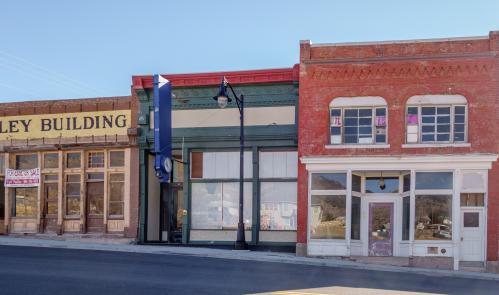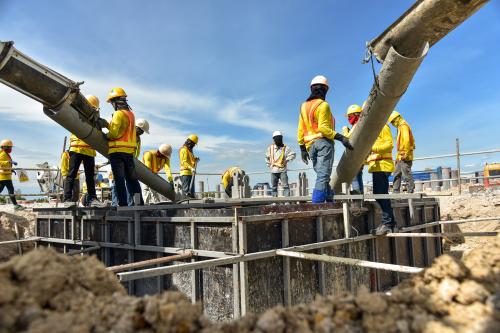This analysis is part of the American Rescue Plan: Strategies for Local Leaders series, a feature of the COVID-19 Metro Recovery Watch.
In April 2020, I published a report calling on Congress to provide federally funded hazard pay for the country’s 50 million frontline essential workers. One year later, little progress has been made. Despite early political momentum last spring, Congress never passed any dedicated federal funding for hazard pay. The six essential workers profiled in that original report still face risks from COVID-19, but without earning any extra compensation for doing so. In the absence of federal funding, it has been mostly left to the resources and willingness of individual employers to provide hazard pay. Most have not.
Now, however, state and local policymakers have an enormous opportunity to finally provide the hazard pay that essential workers deserve. The $1.9 trillion American Rescue Plan Act signed into law in March includes $350 billion in direct relief to state and local governments, and the finances of these governments have proven more robust than was feared, with a number of states even posting budget surpluses. This provides state and local governments the opportunity to immediately harness a portion of the generous federal funding to provide hazard pay compensation to low- and modest-wage essential workers who have risked the most while earning the least. Promising models already exist, including in Pennsylvania, Vermont, Louisiana, Michigan, Virginia, and New Hampshire.
Here’s why more state and local governments should follow these examples with the new federal funding, and how such programs could work.
Why low-wage essential workers deserve hazard pay—and why federal money should fund it
A year into the COVID-19 pandemic, it is clear that our society and economy could not function without the work of millions of low-wage frontline workers, who have kept us fed, healthy, and protected. While everyone in society has benefited from this risky and essential work, the sacrifices have been disproportionately borne by those with the least and who have little choice but to continue to work on the frontlines. Higher-income workers are six times more likely to be able to work from home than low-wage workers, who have fewer choices for safe employment. Since the benefits of essential work are shared across society but the risks are concentrated, publicly funded compensation is warranted to compensate those who have sacrificed the most.
Public funding is also necessary to address federal and state policy failures that have exacerbated this inequity. The federal minimum wage has been stuck at just $7.25 an hour since 2009. While 29 states and Washington, D.C. have set higher minimum wages, 21 states have not.
These low minimum wages disproportionately impact essential workers. Using 2018 data and essential worker classifications from my colleagues Adie Tomer and Joseph W. Kane, Laura Stateler and I found that about half (or 22 million) of workers in occupations with a median wage of less than $15 per hour were essential workers. Nonwhite workers are overrepresented among these low-paid, risky jobs at the COVID-19 frontline. The clearest way for the federal government to permanently raise pay for essential workers is to raise the federal minimum wage to $15 per hour. In the meantime, hazard pay is a stopgap measure to ensure frontline workers earn a living wage while shouldering extreme burdens.
Across dozens of interviews with frontline essential workers over the course of the pandemic, no issue was raised more often than their desire to receive hazard pay. While other policies such as relief checks and tax credits can boost income for essential workers, hazard pay uniquely addresses workers’ desire for compensation for the dangers they face during each shift. Hazard pay is also very popular with the public: A poll last spring found that more than three-quarters of respondents favored employers providing hazard pay to essential workers. A University of California, Berkeley poll from January found that 77% of Californians support legislation requiring employers to provide hazard pay to frontline essential workers until they are vaccinated.
Innovative models from state and local governments
Early in the pandemic, Democratic leaders in Congress embraced the concept of “hero pay” for the country’s essential workers. In May 2020, a $190 billion “Heroes Fund” became the signature component of House Democrats’ $3 trillion HEROES Act, which proposed generous compensation to essential workers across the public and private sectors. Despite this early political momentum, Congress never passed any specific hazard pay funding into law. The “Heroes Fund” legislation languished in the Republican-controlled Senate, and by September, Democrats dropped it.
Fortunately, several innovative hazard pay initiatives led by state and local governments have helped fill the void. Taking advantage of federal funding through the 2020 CARES Act and the Coronavirus Relief Fund, a handful of states introduced creative hazard pay programs that temporarily boosted pay for frontline essential workers. Three states—Pennsylvania, Vermont, and Louisiana—each used $50 million of federal funding to create hazard pay programs for a wide range of essential workers from the private, public, and nonprofit sectors. Pennsylvania and Vermont’s programs, in particular, offer useful models for states seeking to provide hazard pay with new federal relief.
|
Pennsylvania: The COVID-19 PA Hazard Pay Grant Program was a reimbursement-based grant program funded through $50 million in federal CARES Act money. In summer 2020, employers applied for grants to reimburse hazard pay of up to $3 per hour for work performed between August and October, and up to $1,200 total per employee. Eligibility was limited to six key industries, covering both private and nonprofit employers: health care and social assistance, food manufacturing, food retail, transit, security services, and janitorial. More than half of the money went to employers in the health care and care sectors, including home health agencies and care homes, where wages are very low. Apart from 7-Eleven in one county, Pennsylvania’s funding did not go to large Fortune 500 companies. The program had a very strong equity focus, prioritizing workers who are low-paid (earning up to $20 per hour), at high COVID-19 risk, and with the least means to access hazard pay. The $50 million program was very popular, and ultimately could only support 10% of eligible applicants.
Vermont: Funded by federal CARES Act money through the Coronavirus Relief Fund, the Vermont Frontline Employees Hazard Pay Grant Program was administered in two rounds. Employers applied for grants to retroactively cover a lump sum of $1,200 to $2,000 per eligible frontline worker who worked in the spring of 2020. Eligibility was broad across the private and nonprofit sectors to workers at “elevated risk” of COVID-19, including in health care, assisted living and home care, first responder service, janitorial service, food service, trash collection, child care, social programs, security service, and grocery, retail, and pharmacy. The program had an equity focus, with eligibility limited to workers earning up to $25 per hour. Grants were administered on a first-come, first-served basis. Out of hundreds of employers selected for funding, several large, profitable retail chains applied at the encouragement of state officials and the governor, and received funding. They include several of the top retail companies that have earned windfall pandemic profits, including Dollar General, CVS, Home Depot, Target, Lowe’s, Walmart, and a subsidiary of Albertsons. |
The scale of these statewide programs was relatively modest, while the demand was high.
“It wasn’t by accident that it was oversubscribed immediately,” Pennsylvania Governor Tom Wolf said at a recent Brookings event. “Nine-hundred million dollars was requested…18 times what we actually had available. Fifty million dollars for Pennsylvania was a lot of money, but it was not close to being enough.”
Several other states—including Virginia, New Hampshire, and Michigan—used CARES Act dollars to support temporary pay bumps for more specific groups of frontline workers, such as first responders, public sector workers, corrections staff, and care workers.
Hazard pay programs have expanded on the local level, but eligibility is narrow
Dozens of other county, city, and state governments have implemented a patchwork of hazard pay programs for specific groups of workers at different times, but without the scale of the statewide programs.
Recently, city and county governments across California and Washington passed mandates requiring large, profitable grocery, retail, and drugstore chains to provide temporary hazard pay to essential workers. The localities include Seattle, Los Angeles, Los Angeles County, San Francisco, Long Beach, Oakland, San Jose, Santa Monica, Santa Ana, Berkeley, Coachella, Irvine, and others.
The main limitation of local mandates is their narrow eligibility. To expand hazard pay to a broader swath of essential workers, local governments should consider harnessing federal relief money to reimburse other employers that have not seen large profits during the pandemic.
Design principles for state and local hazard pay programs
State and local governments can now take the lead in implementing new hazard pay programs by leveraging the tremendous flexibility of the American Rescue Plan’s $350 billion in state and local aid. In addition, strong support from the Biden administration and clear guidance from the Treasury Department would help build momentum and scale the best initiatives to date.
The following are four design principles that local, state, and federal leaders can consider, building on promising aspects of the Pennsylvania and Vermont models.
- Federally guided, state- and local-led, and employer-provided. While state and local governments will lead on design and implementation, the Treasury Department can issue guidance and outline key principles to guide the use of state and local aid for hazard pay programs, similar to the guidance detailed in the use of Coronavirus Relief Fund money (which was considerably less flexible than this round of state and local aid). The Treasury guidance could include key tenets around eligibility and scope, with some specifics left to state and local governments to determine based on local need, conditions, and priorities. For administrative feasibility, state and local governments should consider reimbursing employers to provide hazard pay; with the exception of Louisiana, most state and local hazard pay programs have been administered through employers.
- Retroactive. Ideally, the Treasury Department will issue clear guidance that allows state and local governments to provide retroactive hazard pay for work performed in the months before the American Rescue Plan Act was enacted, including the deadly winter period when few frontline workers were vaccinated. Most existing state hazard pay programs provided retroactive pay. If Treasury deems retroactive pay prior to the law’s enactment ineligible, state and local governments should provide hazard pay for work performed since March 2021.
- Equity-oriented. Hazard pay programs should have a strong equity focus and prioritize workers who earn low and modest wages, especially those who earn less than $15 per hour. Pennsylvania’s program limited eligibility to essential workers earning under $20 per hour, while Vermont’s program was limited to workers earning less than $25 per hour. State and local governments could consider progressive funding, with the largest hourly amounts (for instance, $3 to $5) allocated to workers earning less than $15 per hour, and a smaller hourly amount (such as $2 per hour) for workers earning between $15 and $25 per hour, or some other threshold that is appropriate for local cost of living.
- Broad eligibility—with exceptions for large, profitable companies. State and local governments should include a broad swath of frontline essential workers for hazard pay eligibility. Some basic eligibility principles include workers in industries the Department of Homeland Security deems “critical infrastructure”; workers who must physically show up to work; and workers who face elevated risks of COVID-19 infection. One possible exception to eligibility is employees at very large, profitable companies. Many of the country’s largest retail chains have earned windfall profits during the pandemic, and with few exceptions, most have not meaningfully shared those profits with workers through sustained hazard pay (with many spending hundreds of millions of dollars or more on stock buybacks instead). Those companies should provide hazard pay out of their own resources, while public funding is prioritized to support smaller employers and companies that have not earned large pandemic profits. Policymakers could explicitly restrict funding to large, profitable companies, or simply discourage them from applying, which may be a sufficient disincentive (large retail companies such as Walmart and Home Depot were initially reluctant to apply for hazard pay funding in Vermont for fear of a public backlash, until state officials encouraged them to do so). Policymakers can either use their bully pulpit to encourage large, profitable companies to provide hazard pay or they can pass mandates—such as those on the West Coast for grocery stores—to compel them to do so.
A clear opportunity for action is finally here
The COVID-19 pandemic has not ended for the country’s 50 million frontline essential workers, even if the public displays of gratitude and most voluntary hazard pay programs have. We cannot forget their sacrifices, nor overlook the underlying inequities and inadequate pay that remain.
There are essential workers in every community across America who have kept their neighbors fed, protected, and healthy over the past year. They deserve far more than our praise. State and local leaders should leverage the American Rescue Plan’s historic infusion of federal relief to provide them the compensation they deserve for the risks they face during the pandemic—a down payment on what should be a permanent living wage.








Commentary
With federal aid on the way, it’s time for state and local governments to boost pay for frontline essential workers
April 6, 2021